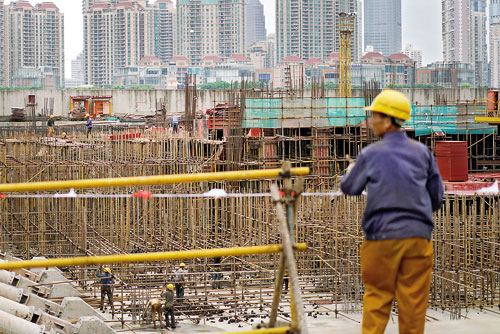Sunday Times 2
The end of poverty in China?
View(s):By Hannah Ryder
BEIJING – One of the most cited statistics about China may well be the number of Chinese who have been lifted out of poverty over the last 35 years. At over 800 million, it is a huge number – and an extraordinary feat. Indeed, no other country has achieved such a level of poverty reduction in such a short period. But what about the millions of Chinese who have remained behind?
China’s government is committed to finishing the task, with the aim of reducing rural poverty essentially to zero by 2020. The authorities first made the pledge at the United Nations in 2015, and have reiterated it in subsequent official settings. But fulfilling that promise – which would now entail improving the wellbeing of about 45 million people, roughly equivalent to Sudan’s entire population – will carry significant costs.

Labourers work at a construction site on the Bund in front of the financial district of Pudong in Shanghai, China. The government is committed to reducing rural poverty to zero by 2020. REUTERS/Aly Song
Poverty reduction, like so many important endeavours, is subject to the law of diminishing returns: the more you do something, the less productive your efforts become. Think of winding a watch: the more you wind, the more resistance builds up in the mainspring, and the more energy it takes to move the stem the same distance.
When it comes to poverty reduction, the people who benefit first are most likely those who were best equipped to do so, owing to, say, their background or geography. By the time there are only a few – or even a few million – left, one can expect reaching them to be much harder.
China’s experience illustrates this phenomenon perfectly. During the first seven years of China’s official “reform and opening up,” which began in 1978, it is estimated that around 110 million people annually rose out of poverty. For the next 15 years – from 1985 to 2000 – the pace of progress slowed considerably, with around 26 million people moving above the poverty line each year. From 2000 to 2015, the figure stood at just over 22 million per year. The government’s target now is to lift ten million people out of poverty annually.
As the pace of poverty-reduction has slowed, its costs have risen – a trend illustrated in a new UN report, together with World Bank data. In 2000, lifting a person out of poverty in China cost the central government approximately $48 per year (in nominal terms). By 2010, this figure had increased more than three-fold, to $150 per year. Now that the government is working to reach the most remote people – those without access to roads, electricity, or clean water – the cost exceeds $200 per year.
This is not to say that China will not be able to meet its 2020 target. On the contrary, the government’s plans and implementation appear as strong as ever. In fact, last year, the government exceeded its target, with 12.4 million people escaping rural poverty. And the budget for this year is 30% larger, meaning that at least $1,000 has been allocated for each of the ten million people China’s government plans to lift out of poverty in 2017.
But, as the government attempts to “get to zero” on rural poverty – by moving all people above the national rural poverty line of CN¥2,230 ($324) per year – it should not lose sight of broader poverty-related challenges. China continues to experience rapid urbanisation – a phenomenon that contributed substantially to past poverty reduction, but that also places a growing number of urban dwellers at risk of destitution.
According to official figures, the average income of the poorest 5% of households in Chinese cities amounts to about $1,128 (CN¥7,521). That is about 3.5 times China’s rural poverty line. But, overall, the average income in cities is at least four times higher than that in the countryside, suggesting that living on such a budget may be even tougher than living at the rural poverty line. And that does not even account for the many migrant workers who live under the radar in cities and are likely to earn even less than the poorest 5%.
These forms of poverty may be even harder to address, not least because China has less experience doing so. Given this, just as China’s successful efforts to reduce rural poverty can serve as a model for others, other countries’ successes in managing urban poverty can – and should – help to guide China’s efforts.
China is far from alone in focusing on the fight to end poverty; indeed, the very first Sustainable Development Goal calls for an end to poverty in all of its manifestations by 2030. With the process becoming increasingly challenging and costly, looking across borders could prove vital to enabling all Chinese to live decent, dignified lives.
(The writer is a former head of policy and partnerships for the United Nations Development Programme in China.)
Courtesy : Project Syndicate, 2017. Exclusive to the Sunday Times.www.project-syndicate.org

